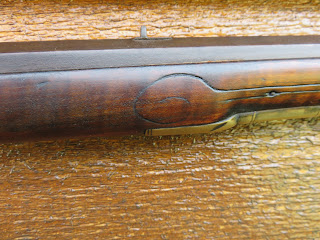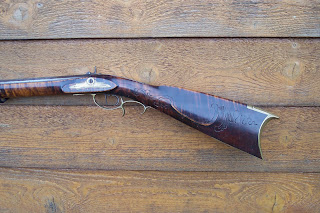Click Picture for Larger View.
Glaze signed in silver inlay on top of barrel.
Seven pierced patchbox, with different panel designs and completely different engraving of the Glaze rifle in part I.
39.5 inch barrel. .44 caliber.
Superb high relief carving.
Engraved eagle in silver oval in cheek-piece. The eagle represents freedom.
Engraved brass side plate.
Brass vent pick holder & hash marks on molding of cheek piece.
Silver fore stock inlay. Incised carving is placed in panels between inlays.
Ketland & Adams flintlock converted to percussion using Bedford hammer.
Fore-stock molding.
Carved termination of fore stock molding.
Nicely done engraving on the brass toe plate.
Below is yet another high relief Glaze rifle.
Artistic wonderful engraved silver inlays, with over the top high relief carving.
Unmolested as found.
"Rare" nine piercings in yet another beautifully engraved patchbox by Glaze.
Altered during period of use to half-stock.
Signed Glaze.
The following rifle is one of his earlier guns. You can also see it on page 33 in " Long Rifles of Virginia" by Butler & Whisker. The barrel is 41 " long, but no doubt cut sometime. The flintlock is a reconversion.
Engraved brass patch box. Push button release.
Incised molding.
Very low relief carving. You can see the influence of the Lauck shop in Winchester Virginia.
Early style side plate with counter sunk bolt holes.
Single Trigger.
Remnants of carving.The last rifle in this group of Glaze rifles is one of his later rifles. While some in the past may have thought this a late Maryland rifle, we believe that it is an Indiana Rifle. This rifle was made during a period when many if not most rifles were more utilitarian , he still produced a refined product.
G W Glaze
He changed his signature a little from earlier guns.
George was not afraid to do different styles, this expanded panel patch box is unlike any we have seen on other rifles by him.
This box has a friction release, while others he made may have a hidden release, or a push button through the toe plate. Again, he did not cast his rifles in a mold.
Incised carving near the entry pipe.
A very long slender rifle, sporting a 45" barrel.
Incised carved molding.
Nicely engraved side plate.
Double set trigger.
More of the Midwestern style or contour.
Double spur brass trigger guard.
.31 caliber, rifling still sharp
Deep incised carving.
-------
GLAZE KENTUCKY PISTOL
The following George W Glaze pistol was made about 1810, at Glazes gun shop along the South Branch of the Potomac 3 miles from Springfield WV.
W. Ketland & Co. Flintlock
8.5" barrel 48 caliber.
G W Glaze
| Hope you enjoyed seeing some of the wonderful work of George W Glaze. Thanks to the collectors who shared them with us. Please do not reproduce pictures. JDM BMS |











































































